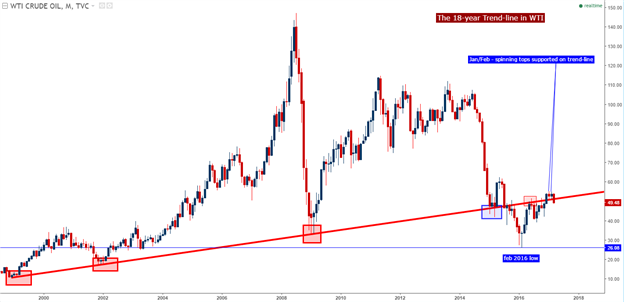Oil prices have spent much of the past 24 hours heading-lower, falling below a key psychological level at $50/brl and a 17+ year trend-line that’s held as support in WTI since mid-December. The catalyst appeared to be a comment from oil magnate Harold Hamm; who warned that U.S. production growth ‘is going to have to be done in a measured way or else we’ll kill the market’. If the past nine years have taught global markets anything, doing things in a ‘measured way’ doesn’t appear to be a popular strategy within the United States economy; and this comment has been construed as a potential pain factor for the future of oil prices.

Chart prepared by James Stanley
In the summer of 2015, the Fed was still under the presumption that lower Oil prices would actually stimulate the U.S. economy. Because the United States had imported so much Oil in the past, a correlation had developed in which lower oil prices would mean more discretionary income for consumers – and this was income that would usually be re-directed towards other purchases. So the money that would normally filter-down to Oil producers could be re-directed towards consumer purchases. But as U.S. shale production continued to grow, the United States dependency on foreign sources of Oil diminished. And as we saw in in Q1 of last year, lower Oil prices could expose a very fragile section of the American economy given this heightened importance on shale production. Many banks were levered-up on debt to energy companies. Lower oil prices made it more difficult to service that debt. And if a group of oil producers with which U.S. banks are highly-levered are all going through the same pain factor at the same time, this could create a capital squeeze within the banking system.
And this really triggers a lot of different fears from a lot of different places. Dwindling oil prices became a major macro headwind in early 2016; but Oil prices reversed and began putting in bullish-moves starting on the second day of Fed Chair Janet Yellen’s Humphrey-Hawkins testimony on February 11th of last year. Since then we’ve seen the insertion of a few additional bullish drivers, mostly on the supply side of the equation as an OPEC deal struck in November helped to further stoke bullish motivation.

















Leave A Comment